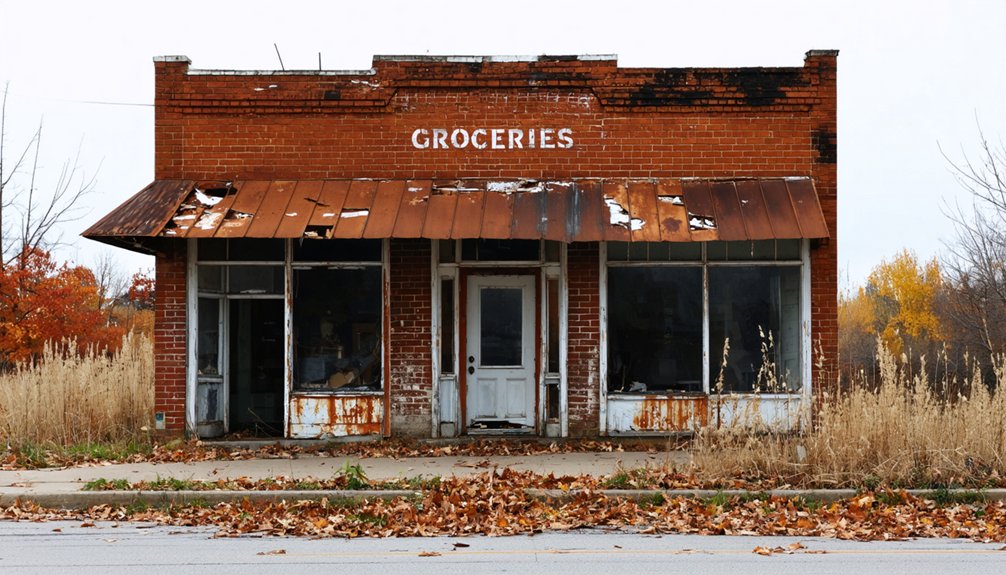You’ll discover Elkport’s story at the confluence of Elk Creek and Turkey River, where a vibrant river town emerged in 1855. For nearly 150 years, the community thrived on fishing, farming, and river trade until May 23, 2004, when catastrophic flooding submerged the town under 8 feet of water. After a federal buyout, most residents relocated, leaving nature to reclaim the land. Elkport’s transformation from bustling settlement to ghost town echoes the fate of many lost Iowa river communities.
Key Takeaways
- Elkport, Iowa became a ghost town after the catastrophic 2004 flood submerged the town under 8 feet of water.
- The town’s residents were permanently displaced through a federal buyout program following the devastating flood.
- Founded in 1855 at the confluence of Elk Creek and Turkey River, Elkport had 88 residents before its abandonment.
- Natural reclamation has transformed former streets and buildings into wildlife habitats with native grasses and wildflowers.
- The town’s legacy is preserved through digital archives, oral histories, and documentation of its transformation from settlement to ghost town.
The Birth of a River Town (1855)
As pioneers pushed westward across Iowa in the mid-1800s, the strategic location where Elk Creek meets the Turkey River caught settlers’ attention, leading to Elkport’s establishment in 1855.
You’ll find that these early settlements often chose locations near waterways, and Elkport’s founders wisely positioned their town to take advantage of both water access and fertile farmland.
The town’s layout reflected the practical needs of its first inhabitants, with plots designated for homes, businesses, and essential services. The settlement derived its name from Elk Creek, which played a vital role in the area’s development.
Community bonds formed quickly among the settlers, many of whom had journeyed from New England and the eastern states. They built their new lives around agriculture and river commerce, creating a self-sufficient town that served as a crucial hub for regional trade and transport. By 2000, the tight-knit community had grown to include 88 residents.
Life Along the Turkey River
You’d find early settlers casting their nets and fishing lines into the Turkey River‘s abundant waters, establishing a modest but significant fishing trade that supplemented farming income.
Native Americans had established year-round villages along these waters long before European settlement, creating a rich legacy of sustainable living from the river’s resources.
The river’s natural course provided essential transportation routes between settlements, with flat-bottom boats and small craft maneuvering between trading posts and homesteads.
The Turkey River, stretching 2 to 4 chains wide, flowed through eight townships and supported diverse wildlife along its forested banks.
Early Fishing Industry Growth
Life along the Turkey River flourished during the early 1800s, driven by an abundance of game fish that supported both commercial and recreational fishing industries. You’d have found trophy-sized walleye, smallmouth bass, and three species of trout thriving in the river’s diverse ecosystem.
The fishing culture shaped early settlement patterns, with communities like Elkport strategically establishing themselves near prime fishing waters.
The river’s economic impact extended beyond direct fishing activities. You would’ve seen a network of bait shops, guide services, and lodging facilities emerging to serve the steady stream of anglers.
The Iowa DNR’s early stocking programs, particularly of walleye fingerlings, helped sustain these fishing-based economies. Cold water tributaries like Chihak Creek provided natural habitat for trout, further diversifying the region’s fishing opportunities.
River Transportation Routes
While steamboats dominated Iowa’s major waterways from 1846 to 1866, the Turkey River’s challenging conditions thwarted attempts to establish reliable commercial navigation.
You’d have found river commerce concentrated instead on ferries and barges, which served as crucial transportation links until permanent bridges were constructed. The most significant breakthrough came in 1853 when Elkader built its first bridge, though it required constant repairs. In 1941, the historic Little Church Road Bridge was relocated here to provide a vital crossing point.
When winter ice halted water transport, you would’ve seen horse-drawn sleighs and floating barges maintaining essential supply routes. Like modern security verification processes, these systems helped ensure only legitimate traffic could pass through.
These transportation challenges ultimately pushed local communities to invest in alternative infrastructure, including improved roads connecting to Mississippi River trading hubs. The development of Route 13 and other overland routes helped overcome the Turkey River’s limitations as a commercial waterway.
The Fateful Day: May 23, 2004
On May 23, 2004, thunderstorms released catastrophic flooding across northeast Iowa, delivering a devastating blow to the small town of Elkport.
Despite generations of flood preparedness, the community’s resilience couldn’t withstand the unprecedented force of nature that day. Record-breaking rainfall of 8-10 inches pummeled the Turkey River Basin within 72 hours, while the confluence of the Turkey and Volga Rivers created an unstoppable surge of water.
Even decades of preparing for floods proved futile against nature’s raw power that day, as record rains overwhelmed the river basin.
When the south-end levee breached for the first time in 50 years, you’d have witnessed Elkport submerge under 8 feet of water within hours. The Town Hall was surrounded by the raging floodwaters after the dike gave way.
The Turkey River at Garber reached a staggering discharge of 66,700 cubic feet per second – a 500-year flood event that would forever alter this historic town’s destiny.
Rising Waters and Broken Levees
Rising floodwaters exposed the vulnerabilities of Iowa’s aging levee system during that fateful spring of 2004. You’d find similar scenarios playing out across the state, where half of the inspected levees showed operational deficiencies that threatened their structural integrity. Recent assessments indicate that repairing these critical structures will require hundreds of millions to complete.
The flood management situation was particularly dire, as communities like yours faced risks comparable to the devastating 1999 event that left Fayette under 10 feet of water.
As you’d discover, these weren’t just isolated incidents. The levee failures put thousands of your neighbors at risk, disrupted essential transportation networks, and threatened the region’s economic stability.
Community resilience would be tested as environmental hazards mounted, including compromised sewage treatment facilities and the looming threat of mudslides – all consequences of an overwhelmed and aging flood control system.
A Community’s Fight for Survival

The devastating floods of 2004 marked the beginning of Elkport’s final chapter as a living community.
You’d find residents desperately trying to salvage their belongings as more than 8 feet of water submerged their town, showcasing remarkable disaster resilience in the face of catastrophic loss.
Their community attachment ran deep – many had never called anywhere else home since the town’s 1855 founding.
For generations, Elkport’s families knew only one home – their cherished town nestled along these waters since 1855.
But despite their determination to rebuild, the federal government’s declaration of Elkport as a flood zone left them with an impossible choice: accept the buyout and relocate, or risk losing everything.
By 2006, nearly 90 residents were forced to abandon their hometown.
While buildings could be demolished, they couldn’t erase generations of memories, leading residents to document and preserve their heritage before Elkport became a ghost town.
Today, only an empty field remains where the once-thriving community stood, with just the historic church spared from demolition due to its elevated position.
The Decision to Leave Home
When floodwaters breached Elkport’s levee in 2004, you’d have witnessed over 85 residents facing the devastating reality that they couldn’t return to their generational homes.
You’d have seen families wrestling with the federal government’s buyout offer – their only viable option after the town was declared unsafe for habitation and ineligible for rebuilding funds.
Your heart would have ached watching neighbors pack their cherished belongings and bid farewell to the close-knit community they’d built since 1855, knowing the rising waters had permanently altered their way of life.
Heartbreaking Community Exodus
In May 2004, life changed forever for Elkport’s 88 residents as floodwaters breached the town’s south-end levee, submerging homes and businesses under eight feet of water within hours.
You’d never imagine the emotional trauma that followed as you watched your community face an impossible choice: accept a government buyout or risk future disasters without support.
The exodus proved devastating to community resilience. You’d see your neighbors scattered to different towns, breaking bonds that had existed since 1855.
Bulldozers arrived by September 2006, demolishing what remained of your heritage. Streets where you’d grown up, the church where you’d worshiped, and homes filled with generations of memories – all reduced to empty fields, leaving only your cherished stories of a town that once was.
Assessing Life-Changing Options
Facing unprecedented devastation, Elkport’s residents grappled with life-altering decisions that would reshape their futures forever.
You’d find yourself weighing the harsh reality: rebuilding wasn’t just about structures – it was about economic viability. The federal government’s buyout programs offered a lifeline, but accepting meant surrendering your community identity.
As you stood among the ruins of flooded homes and destroyed infrastructure, you’d realize the Turkey River’s threat wouldn’t disappear. The flood zone designation made insurance costs prohibitive, while the loss of essential services meant starting from scratch.
Despite your deep emotional ties to generations of memories, you’d have to choose between clinging to a vulnerable past or embracing an uncertain future elsewhere. For most residents, the practical choice won over the sentimental one.
Rising Waters Force Change
The catastrophic convergence of the Turkey and Volga Rivers on May 23, 2004, shattered Elkport’s defenses as floodwaters breached the town’s south-end levee for the first time in fifty years.
Within hours, over eight feet of water submerged the town of 88 residents, forcing an immediate evacuation that would prove permanent for most.
Despite the community’s resilience in facing previous floods, this unprecedented disaster transformed their reality.
The environmental awareness gained from repeated flooding, particularly the devastating event of 1999, ultimately shaped their future.
By 2006, you’d find most residents accepting federal buyout assistance, choosing to relocate rather than rebuild in the flood-prone area.
The decision to abandon Elkport wasn’t just about leaving homes behind – it was about acknowledging nature’s power and adapting to survive.
Federal Buyout and Demolition
After devastating floods struck Elkport in 2004, federal officials launched a thorough buyout program that would forever alter the town’s destiny.
You’ll find that federal assistance became the primary lifeline for residents who’d lost nearly everything when the Volga River devastated their community.
Despite their remarkable community resilience, the townspeople faced limited options.
Nature Reclaims the Land

If you’d visited Elkport after the devastating 2004 flood, you’d have witnessed nature’s swift reclamation of the townsite, as native grasses and riparian plants sprouted through the mud-caked remnants of streets and home sites.
The surviving mature trees stood as silent witnesses among the new growth, their roots adapting to the waterlogged conditions while saplings and shrubs colonized areas where buildings once stood.
The Volga and Turkey Rivers continued reshaping the abandoned landscape, their periodic flooding depositing new sediments and sustaining the marshy conditions that now characterize this ghost town’s terrain.
Wild Flora Takes Over
Following Elkport’s devastating 2004 flood and subsequent federal buyout in 2006, nature quickly began reclaiming the abandoned town site.
Pioneer species of grasses and wildflowers were the first to establish themselves in the disturbed soil where buildings once stood. You’d have seen rapid ecological succession as hardy plants colonized former streets, yards, and public spaces.
Within a decade, you could witness the remarkable post-flood recovery as native species transformed the urban abandonment into thriving wildlife habitat.
The increasing plant diversity attracted insects, birds, and mammals, accelerating ecosystem dynamics. Where homes and businesses once stood, you’ll now find dense thickets of sumac and dogwood, while cottonwoods and willows create a developing canopy.
This natural habitat restoration has effectively erased most visible traces of human occupation.
River Reshapes Former Streets
When the Turkey and Volga Rivers breached Elkport’s south-end levee in May 2004, the ensuing floodwaters dramatically reshaped the town’s street network within hours.
Today, you’ll find nature has reclaimed what was once a thriving community, as river dynamics continue to transform the landscape.
The flooding’s impact on Elkport’s streets was devastating and permanent:
- Eight-foot floodwaters submerged roads under thick layers of mud and debris
- Erosion and sedimentation erased recognizable street grids
- Natural vegetation now covers former roadways and building foundations
What you’re seeing now is a floodplain restoration area where streets once existed.
The land has returned to its natural state, with subtle terrain variations being the only hints of Elkport’s former street layout.
The river’s power has transformed this once-inhabited space into an open floodplain, forever changing how humans interact with this landscape.
Preserving Elkport’s Legacy
Although Elkport’s physical structures no longer stand, the town’s legacy endures through multiple preservation efforts spanning historical documentation, oral histories, and digital archives.
You’ll find extensive historical documentation detailing Elkport’s 150-year journey, from its 1855 establishment to its final days following the devastating floods. Community narratives live on through former residents’ personal accounts, photographs, and cherished memorabilia.
You can now access Elkport’s story through online platforms, educational resources, and social media archives that chronicle the town’s history.
Local historians and preservation commissions continue cataloging Elkport’s heritage within broader initiatives to document Iowa’s lost towns, ensuring that future generations will understand the impact of natural disasters on rural communities and the resilience of their inhabitants.
Iowa’s Lost River Communities

Elkport’s story parallels the fate of numerous other Iowa river communities that have vanished beneath the waters of progress. When Lake Red Rock was created in the 1960s, six lost communities disappeared forever, taking with them a rich cultural heritage that had flourished along Iowa’s riverbanks.
- Coalport, once a bustling coal mining town with mills and pottery works, succumbed to the river’s changing course in 1903.
- Cordova, established by the Wabash Railroad in 1887, supported a mere 17 residents before surrendering to Lake Red Rock’s waters.
- Red Rock and its neighboring towns left behind submerged cemeteries and abandoned infrastructure as silent testimonies to their existence.
You’ll find these communities’ legacies preserved today through local histories and in the recreational waters that claimed their streets and stories.
Frequently Asked Questions
Are There Any Remaining Structures or Ruins Visible in Elkport Today?
You’ll find very few remaining landmarks, with only the elevated church and an old community center standing as reminders of historical preservation efforts. Most structures were demolished, leaving empty lots nature’s reclaimed.
What Were the Main Businesses and Industries in Elkport Before 2004?
You’d find agricultural activities dominated the economy, with local businesses like blacksmith shops, farm equipment repair services, small retail stores, and banks serving the farming community’s needs.
Did Any Residents Refuse to Leave During the Federal Buyout?
While resident testimonies show some initially delayed moving to save belongings and community memories, there’s no evidence anyone permanently refused the federal buyout. Most residents ultimately chose to relocate.
What Is the Closest Inhabited Town to Former Elkport’s Location?
Like a sentinel standing watch over abandoned dreams, Garber, Iowa stands as your closest inhabited neighbor to the ghost town’s remains – barely a stone’s throw from where local history took its watery turn.
Were Any Historical Artifacts or Documents Saved Before the Demolition?
You’ll find historical preservation was limited, with residents informally salvaging photos and memorabilia. Metal detectors have aided artifact recovery, though no organized archaeological efforts preserved documents before demolition.
References
- https://khak.com/ghost-town-what-happened-to-elkport-iowa/
- https://www.onlyinyourstate.com/trip-ideas/iowa/spooky-small-town-in-ia
- https://www.youtube.com/watch?v=dH9drscgdXs
- https://rural-ruin.livejournal.com/632968.html
- https://www.youtube.com/watch?v=JcAFM6isynY
- https://www.starnewsonline.com/story/news/2006/09/22/workers-destroy-whats-left-of-iowa-town-deserted-after-04-flood/30275862007/
- https://en.wikipedia.org/wiki/Elkport
- https://kids.kiddle.co/Elkport
- https://upload.wikimedia.org/wikipedia/commons/2/21/History_of_Clayton_County
- https://archive.org/stream/historyofclayton01pric/historyofclayton01pric_djvu.txt



